Genus
Geophagus
Text and photos by Alf Stalsberg,
unless otherwise indicated.
CLICK ON ANY IMAGE TO ENLARGE IT
Keeping cichlids like the Geophagus has been increasing a lot, not only in the past year, but for some years now.
When you study the Geophagus a little more closely, you will understand why. They are beautiful, very elegant and most of them are very peaceful, not only with other fish but also among themselves. This should give those of you, not familiar with these cichlids, some hints. I will discuss the general things about Geophagus here in the beginning and then I will show you photos of at least some of them.
The Geophagus have everything you could want from cichlids. They are colorful, have very interesting behavior, and can go together with most fish in community aquariums.
There are of course things you have to take care of, such as temperature, size of the tank, feeding, hiding places, water quality is very important. If you wanted to keep a group of Geophagus in a community aquarium, then the tank must be at least 250 liters or bigger if you have room for it.
You must also think about what kind of plants you want to use. In most of the biotopes where the Geophagus live, there are not many plants, but if you wanted the community tank to be in the livingroom, I guess there will be some complaints if you just use rock and bogwood, which is a realistic biotope for the Geophagus.
Fine sand is also a part of the whole, since the Geophagus spend most of their time looking for food by sifting the sand to find it. If you want the sand to be highest in the background and lowest in the front ... you can forget that. When Geophagus take a mouthfull of sand and chew on it, they don't spit it out in the same place, but spread it around. So after a short time the substrate will be flat.
Geophagus altifrons
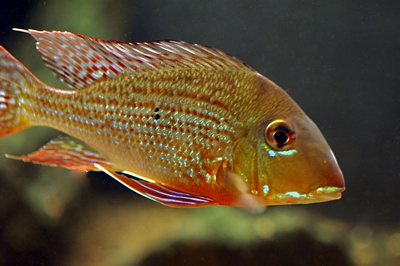 |
Geophagus altifrons. |
I have heard some people have put gravel instead of fine sand to avoid the digging. But then you better find other fish, because to sift the sand looking for food is natural for the Geophagus.
When you go looking for Geophagus you must be patient, because when you go in to a shop and look for them, if you are lucky you might find some dull-gray fish.
It will take about two years time before the fish will show you how it will look when it's healthy and in good condition. So meanwhile you must look at some good books about Geophagus and I will give you the name on the books I'm thinking of. One very good book I will suggest is a German book, namely `Die Buntbarsche Americas' Band 3, ISBN 3-8001-3990-1. I know it's written in German, but even if you can't read German, just look at the picture about Geophagus. The book cover about other cichlid too. And the book is written by two of Germany's best-known Aquarists, namely Uwe Werner and Rainer Stawikowski. I know them personally, and they are a couple of great guys. The other book I was thinking about, is also in German, by a great guy, but you can get it in English too. The name of the book is `South American Eartheaters' by Thomas Weidner, ISBN 0-9668255-1-9.
Geophagus brachybranchus
Geophagus brachybranchus. |
|
This is probably one of the Geophagus you have never seen in the shop, and it will probably be some years before it's common. The name of the fish is Geophagus brachybranschus from Surinam. It was described in 1989 by Dr Kullander and Dr Han Nijssen in the book `The Cichlids of Surinam'. It was first collected in Nickerie River system in a rocky pool, just above Blanche Marie vallen (falls) in January, 1971.
Geophagus surinamensis
Here is a newly collected Geophagus surinamensis from the Surinam River. |
|
We collected this fish outside the village of Brokopondo. The bottom layer was fine sand and some bigger logs, there were a lot of fish and we also collected Guianacara owroewefi, Crenicichla sp., Apistogramma steindachneri and Rineloricaria sp.
This was a nice place to stay and collect fish. We lost many of the Geophagus surinamensis in the bags, I don't know why. It was probably something they had in their stomachs, because we changed water very often so they were empty. There was no problem transporting the fish.
Geophagus prefer to be in flocks or groups of at least six, 10 fish is better. To me it looks like they feel safer in groups. If there are just a couple they will hide and they will not show their beautiful colors.
Today there are many Geophagus, but there are also many that are still not described or not even found. You need to be patient too, because when you see small fish in the shop, they are usually not bragging with nice colors. But take them home and give them good conditions, a rather large aquarium, change plenty of water and give them a good diet.
'Geophagus' pellegrini Regan 1912
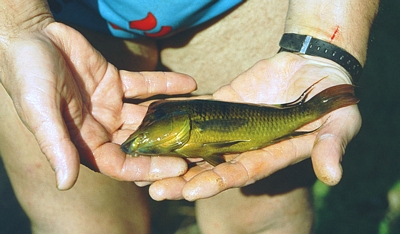
ABOVE: This 'Geophagus' pellegrini male was collected in Choco near the village of Panamericana in Colombia. |
BELOW: A young male in the aquarium. 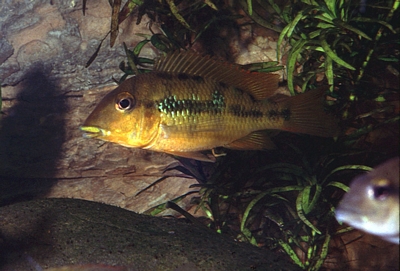 |
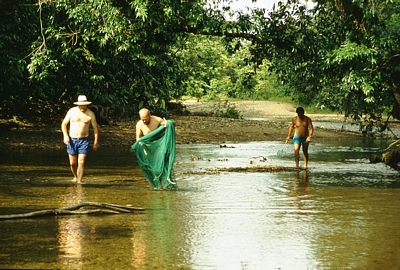 ABOVE: Rio Pepe out in Choco, was one of the biotopes we collected 'Geophagus' pellegrini, and this was a beautiful biotope. ABOVE: Rio Pepe out in Choco, was one of the biotopes we collected 'Geophagus' pellegrini, and this was a beautiful biotope. |
BELOW: A female 'Geophagus' pellegrini. 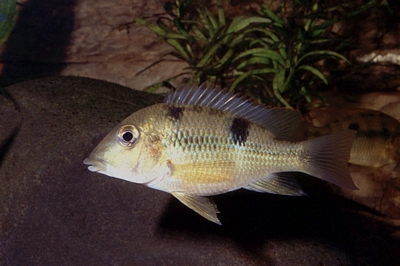 |
Geophagus pellegrini was described in 1912 by Regan, and can reach a length close to 20 cm TL if they have a fair-sized tank and are kept in good conditions. The fish is a direct mouthbrooder and the eggs are taken up by the female as soon as the male has fertilised them.
My fish layed between 2-3 eggs at the time, and I don't remember exact how long they were laying eggs, but around an hour or so. As first food for the fry, newly hatched Artemia salina is very good, you see the fry get red bellies.
'Geophagus' pellegrini is a beautiful fish when they attain a reasonable size, and I can highly recommend them. It's not very easy to find, because when shops say they have 'Geophagus' pellegrini, it is usually 'Geophagus' steindachneri.
Cichlid Power,
Alf
DISCLAIMER: Statements made on this page are not herewith made available for the purpose of zoological nomenclature
under the International Code of Zoological Nomenclature.
Copyright 1995- Alf Stalsberg – Cichlid Power